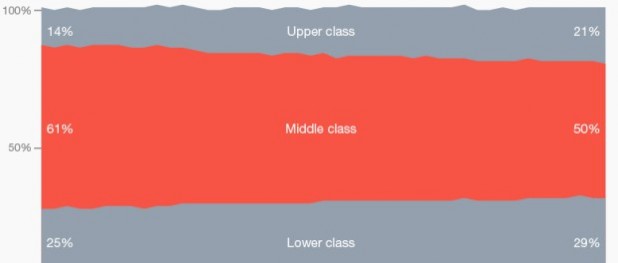Hunter Wallace
Occidental Dissent
December 12, 2015
The Pew Research Center has a massive new study out which shows the US middle class is losing ground:
“After more than four decades of serving as the nation’s economic majority, the American middle class is now matched in number by those in the economic tiers above and below it. In early 2015, 120.8 million adults were in middle-income households, compared with 121.3 million in lower- and upper-income households combined, a demographic shift that could signal a tipping point, according to a new Pew Research Center analysis of government data …
Fully 49% of U.S. aggregate income went to upper-income households in 2014, up from 29% in 1970. The share accruing to middle-income households was 43% in 2014, down substantially from 62% in 1970.
And middle-income Americans have fallen further behind financially in the new century. In 2014, the median income of these households was 4% less than in 2000. Moreover, because of the housing market crisis and the Great Recession of 2007-09, their median wealth (assets minus debts) fell by 28% from 2001 to 2013.”
The Pew study doesn’t hazard to guess why the American middle class has shrunk in relative size in every consecutive decade since 1971. I believe, however, that I have found the answer:
“When and how did the free-traders capture America?
If one year could mark their decisive victory, it would be 1934, with the passage of the Reciprocal Trade Agreements Act. And if one year could be cited as the inauguration of the free-trade era, it would be 1967, with completion of the Kennedy Round of trade negotiations.”
The Kennedy Round of GATT was the fateful moment when America leapt off the cliff and went full retard on free-trade:
“In 1967 America arrived at the final crossroad. The Kennedy Round of trade negotiations under GATT was stalled. Europeans were balking at U.S. demands to further open their markets to American agriculture; Japan had given a flat no to greater market access. Fear gripped Washington. The talks were on the verge of collapse.
The U.S. trade negotiators went to see President Lyndon Johnson. Failure to end the Kennedy Round successfully, they warned, would return global trade to “jungle warfare,” risk “spiraling protectionism” in the United States, and “encourages strong forces now at work to male the [European Common Market] into an isolationist, anti-U.S. bloc, while, at the same time, further alienating the poor countries.” If America did not make the necessary concessions, disaster was certain.
Again the United States capitulated; and Commerce Secretary Alexander Trowbridge rejoiced.”
Buchanan continues:
“LBJ crushed the uprising with a flat declaration. No quota bill will “become law as long as I am president and can help it.” By the end of the sixties, early returns from the Kennedy Round were coming in. America had entered a new era”
He quotes trade historian Alfred E. Eckes, Jr.:
“Viewed from a historical perspective, the Kennedy Round marked a watershed. In each of the seventy-four years from 1893 to 1967 the United States ran a merchandise trade surplus (exports of good exceeded imports). During the 1968-72 implementation period for Kennedy Round concessions, the U.S. trade surplus vanished and a sizeable deficit emerged. For twenty of the next twenty-two years, the United States experienced merchandise trade deficits – as much as $160 billion in 1987.”
Buchanan explains what happened next after the Kennedy Round was implemented from 1968 to 1972:
“The Kennedy Round tore down the levees, and floods of imports poured in from low-wage nations. With the tariff collapsed, American companies had a powerful incentive to relocate factories abroad, to take advantage of the low-wage labor and then export back to the United States. Journalists were soon writing excitedly about the Japanese “miracle” and the “tigers” of Asia – Singapore, Hong Kong, Taiwan, South Korea. Few asked at whose expense this sudden Asian prosperity had come.
One after another of the great U.S. industries began to decline, depart, or die. The radio- and television-manufacturing industries disappeared. The antifriction-bearings industry and machine-tool industry were gutted. The mighty auto industry was ravaged. Five years after the Kennedy Round, foreign penetration of the U.S. auto market had doubled, to 16 percent. But in Europe and Japan, internal tariffs, targeted at American-made cars, kept U.S. exports from making comparable gains.”
Back to trade historian Alfred E. Eckes, Jr.:
“In the twenty years after 1970 the opportunities Kennedy foresaw vanished for high-paid but relatively low-skilled U.S. workers. From 1972 to 1992 the United States created 44 million net jobs – particularly in services and government. However, America generated no net jobs in internationally traded industries. Japan and many of the other rapidly industrializing powers – Taiwan, South Korea, and Brazil among others – enjoyed rapid economic growth, not because they practiced free trade at home, but because they enjoyed access to the open American market. Like nineteenth-century America, they practiced protectionism at home while America’s generous market-opening policies provided boutiful export opportunities. Paul Bairoch noted the lesson: “Those who don’t obey the rules win.”
With the sole exceptions of 1973 and 1975, the US has ran a trade deficit with foreign countries since 1971, 42 out of the last 44 years of the free-trade era. Isn’t that an amazing coincidence?
Of course there were many other things going on in the US in 1971 that also contributed to this turning point: the most important being the great tidal wave of Third World immigration that followed the Immigration Act of 1965, the end of the Bretton Woods system after Nixon floated the dollar, the decimation of organized labor in the 1970s and 1980s, and Ronald Reagan’s changes to the tax code.
Note: The excerpts above come from Pat Buchanan’s book The Great Betrayal which was published in 1998.
From the Pew study:
“Overall, the economic stagnation that has characterized this century so far has set the welfare of households back by at least 15 years. For upper-income households, the median income in 2014 was comparable to its level in 1998. The median for middle-income households in 2014 is similar to its level in 1997, and for lower-income households the median income has retreated to its level in 1996.”
Incredible.
After Bush and Obama, the median household income in 2015 is comparable to its level in 1998, 1997, and 1996 for the wealthy, the middle class, and the poor respectively. Economically speaking, it is like the 21st century never happened after two presidents, a Republican and Democrat, who were equally committed to free-trade and open borders.
 Daily Stormer The Most Censored Publication in History
Daily Stormer The Most Censored Publication in History



